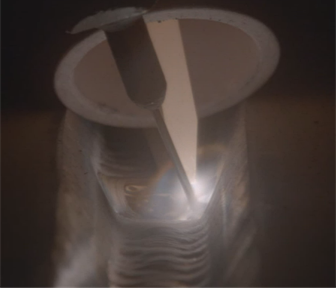In most situations, a high dynamic range (HDR) image that provides a clear view of the weld arc and immediate work environment is enough to provide operators everything they need to control or adjust their welding process. Typically, such images are provided in monochrome because, in certain circumstances, it provides better image saturation and fidelity. Monochrome images can accentuate the light and shadows of a welding scene, making the texture of the welding surfaces, torch tip, wire and melt pool easier to see. Images with a wide range of tonal values, such as what might exist in a high dynamic range image of a welding scene, tend to work well in monochrome. This is especially the case when the tones in the image range all the way from the blackest blacks of the background to the whitest whites of the welding arc, with lots of varying grey tones in between.
However, for some welding situations, color imaging that delivers high dynamic range imaging has particular value. The presence of color allows the boundary of aspects of the weld process to be easily detected by the operator. Bright hues that highlight an element, such as the melt pool, shielding gas or torch tip can improve the visibility of that object to the operator.

Color Image of a Manual TIG Process
Of all the types of welding, perhaps the most suitable for color imaging is GTAW (TIG). Some of the features that are better seen with color in a TIG process include:
- Melt Pool: Better edge definition and detection of flow of molten material.
- Shielding Gas: Operators are able to see if there is any shielding gas present. Also, each shielding gas mixture typically has its own signature certain color. If the gas chemistry in the welding environment changes, then so does its color.
- Oxidation: Very easy to detect the presence of flames resulting from the burn-off of any oils or impurities.
- Heat Affected Zone (HAZ): The leading edge of the heat affected zone can be detected in the parent material as it typically colorizes at elevated temperatures. This can indicate the amount of heat penetration and energy transfer.
- Temperature Indicator: Operators can clearly see discoloration of metal due to excess heat in the welding process.
- Torch Tip: Easier to see the definition of the torch tip and cup relative to the weld arc. Allows the operator to monitor the impurity build up on the torch tip and spatter presence on the cup.

Narrow Gap TIG Welding – Color Exposes Different Details
Conclusion
Ultimately, the choice of whether to use color or black and white camera technology depends on what feels right for the operator. Nevertheless, for certain welding operations such as TIG, the use of color imaging can significantly enhance the clarity and detail of the image, thereby improving the operator’s ability to detect even small changes in the weld scene.
For more information on how Xiris Color Weld Cameras can help monitor your weld processes, visit Xiris.com
Sign up to receive our Weld Video of the Month




.png)

